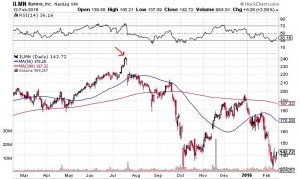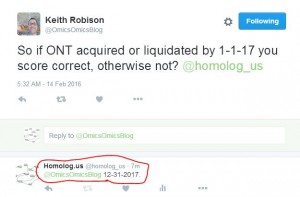
Our #AGBT16 Forecast - Oxford Nanopore Will Go Out of Business by 2017
Investor warning: The following post is for entertainment purpose only, and should not be considered as financial advice of any sort. Please consult your favorite government-certified investment adviser or central banker to decide, where to invest your life savings.
-———————————————————
Our regular readers know that our track record for making bold forecasts is not at all good. Please allow us to keep trying so that we can improve our skills.
Oxford nanopore appears to be on a roll. This morning, Nick Loman presented at the AGBT conference on his work on Ebola detection. His work was recently published in Nature.

Elsewhere, Omics!Omics! blog wrote a few weeks back -
When it comes to Nanopore, am I too GAGA?
SCIENTIFIC DREAM INCARNATE
When I first rotated in George Church’s lab in the summer of 1992, I naturally met each person and inquired as to their project. A post-doc named Rich told me a crazy idea of Georges that one might be able to sequence DNA using patch- clamp techniques as the DNA passed through a pore in a membrane. Later, Rich had a patch clamp setup – it was on a vibration-isolating table enclosed in a Faraday cage. It was at least the size of a desk. Even with all that, Rich would say he could tell who was walking down the blind hallway adjacent to it, based on the cadence from the footsteps creating noise on his instrument.
Fast forward 22 years, and we have our MinION at Starbase, ready to go. No air table, no Faraday cage – and I could stuff a shirt pocket with half a dozen of them. We loaded it with a library which my colleague created, and let it run. Then I looked a the data. Much of it was junk, and the yields that MinKNOW promised of long reads just weren’t there – but what was there was a single read which could be recognizable aligned to the entire 48.5 kilobases of lambda phage. Kaboom! That’s one hell of an amazing read.
We also wrote about “Two Potentially Important Developments on Nanopore”, and one of those developments was considered as paradigm shift by Mick Watson (Did you notice the paradigm shift in DNA sequencing last week?).
Despite all those positives, things are not looking good for Oxford Nanopore IMHO. Let us present our assessment for making the bold call in the title.
-——————————————————
**1. Amazing technology **
Nanopore fans often highlight the amazing technology that the company has built. Historically, companies with mind-boggling technologyies do go down from time to time, and supersonic plane Concorde is the best example of that. Amazing technology does not cut alone, unless a number of other factors are supportive, as listed below.
-——————————————————–
2. Investment and valuation

Oxford Nanopore raised large amount of money in mid-July 2015, and the arrow on the above chart shows the exact date when the public announcement was made. The comparison with Illumina is significant, because usually the investors make valuation decision based on important public companies. Illumina, being the 500 pound gorilla in the sequencing space, is likely that benchmark.
Fast forward to today and you see Illumina’s valuation being cut by nearly half as of today. That means high-flying unicorns (i.e. profitless private companies with >$1B valuation) are expected to lose even more on their valuations.
However, not being able to raise more money is not a business-killer, unless large investments are mismanaged.
-——————————————————–
3. Mismanagement
Readers many have noticed a tweet related to ‘Prometheon’ in our yesterday’s blog post from AGBT.

That appears rather innocuous, because companies sometimes have delay in delivering products. However, once you go through the comments at Glassdoor, a rather ominous picture develops. One persons says the CTO ‘announces products that don’t exist and before we know if they’re possible (usually they’re not and so we waste months and millions)’. Is ‘Prometheon’ one such product?
“Management don’t to listen to engineers”
I have been working at Oxford Nanopore Technologies full-time
Pros
You can work on interesting projects if you’re in the right team, opportunity to move between teams, friendly staff, opportunity to go on training courses, good private healthcare package, very commutable location.
Cons
The company is badly mismanaged - engineers are routinely ignored and as a consequence people take to glassdoor to vent. The CEO thinks that the organisation is very communicative and therefore makes zero effort to listen to technical staff (CEO just makes a bad joke about P45s every few months to nervous laughter). The attack on the CTO by the previous commenter isn’t completely justified, he’s not as scientifically illiterate as made out. However he does need to go - he announces products that don’t exist and before we know if they’re possible (usually they’re not and so we waste months and millions), and shuts people off mid-sentence if they disagree with him. He also posts bizarre things on the internet. The main effect of this is that engineers feel frustrated and unable to make ourselves heard.
Advice to Management
Make a real effort to improve communication, with everyone, don’t make them feel like they will be demoted/fired if they disagree with you. Rein in CTO.
Interesting tech but political
Pros
Good pay and benefits (private healthcare). Overtime is not required, though sometimes appreciated. Can in general be reimbursed for holidays not taken or carry them over to the next year. Basic technology is really interesting, and important (significant scientific and social impact). Regular bonuses and employees receive share options.
Cons
I didn’t like the management style very much, seemed quite political at times. I guess having raised so much money there was a huge pressure to hire, and large teams were formed without them really having work to do. Management seems quite isolated from the reality of what’s happening.
Advice to Management
Restructure, smaller more focused groups. Address issues with political individuals.
“This place is doomed”
I have been working at Oxford Nanopore Technologies full-time (More than 5 years)
Pros
The vision isn’t bad. The people in the trenches are brilliant and wonderful. The tech is cool.
Cons
The management, the management, the management, the management. The endless politics, the backstabbing, the lack of recognition.
Advice to Management
Stop keeping people in the dark. Stop playing games with people’s lives. Try to have a sense of humor.
-——————————————————–
4. Cost
One question that often keeps coming back is how much it costs to do the ‘cool USB sequencing’ after various factors are included. For example, Jason Chin from Pacbio asked in tweeter about the total cost of Loman’s Ebola sequencing.

USB sticks being used in computers are popular not only because they are portable, but also because they are cheap. Is that the same for nanopore ‘sticks’?
This point about cost is intricately related to 2 and 3, because (i) a company with large investments and high valuation needs to raise prices to pay for the investment, (ii) if the company is not managed in a lean manner, that reduces room for cutting costs.
-——————————————————–
5. Not so amazing technology yet
Our point 1 was about ‘amazing technology’ as seen from the point of view of the fans of the company. Their tweets made us re-evaluate various papers at biorxiv, and we are not so enamored on this point.
For example, in our previous blog posts, readers mentioned the space as a potentially big application for the technology. They may take a look at the following paper from NASA, who did not manage to make good use of the sequencer. After they did a full evaluation, they wrote -
Nanopore Sequencing in Microgravity
The ability to perform remote, in situ sequencing and diagnostics has been a long-sought goal for point-of-care medicine and portable DNA/RNA measurements. This technological advancement extends to missions beyond Earth as well, both for crew health and astrobiology applications. However, most commercially available sequencing technologies are ill-suited for space flight for a variety of reasons, including excessive volume and mass, and insufficient ruggedization for spaceflight. Portable and lightweight nanopore-based sequencers, which analyze nucleic acids electrochemically, are inherently much better suited to spaceflight, and could potentially be incorporated into future missions with only minimal modification. As a first step toward evaluating the performance of nanopore sequencers in a microgravity environment, we tested the Oxford Nanopore Technologies MinIONTM in a parabolic flight simulator to examine the effect of reduced gravity on DNA sequencing. The instrument successfully generated three reads, averaging 2,371 bases. However, the median current was shifted across all reads and the error profiles changed compared with operation of the sequencer on the ground, indicating that distinct computational methods may be needed for such data. We evaluated existing methods and propose two new methods; the first new method is based on a wave-fingerprint method similar to that of the Shazam model for matching periodicity information in music, and the second is based on entropy signal mapping. These tools provide a unique opportunity for nucleic acid sequencing in reduced gravity environments. Finally, we discuss the lessons learned from the parabolic flight as they would apply to performing DNA sequencing with the MinIONTM aboard the International Space Station.
CTO of the company challenged their assertion in the comment section, and his point is scientifically valid. The larger point is that NASA did not find the technology easy to use, and it will possibly take several iterations before they pay for it. At this point, they remain to be unconvinced customers.
I am highly sceptical that gravity changes the operation of the chemistry which works on a very small scale and is driven by ion flow and diffusion - and there isn’t enough data here to test that hypothesis fully yet anyway. There are lots of other things that might indirectly affect operation of the entire system, the simplest being that you had bad chips - but even so, given the amount of data, at this stage i’d be sceptical that the differences you have seen do not have simpler causes or are just statistically insignificant.
An interesting alternative might be instead, for example, take a MinION system that is operating normally from the start so providing a baseline, drop it from a tall building in a box, and continue to record the data. As I understand, the vomit comet is simply freefall in an enclosed space removing decelerating wind resistance. This drop experiment, whilst short lived, would at least provide an internal control for the setup, chip quality, buffers, operator etc and any changes in state from baseline ‘normal’ caused by the freefall itself could be seen against that. My bet, just a bet, is that there wouldn’t be any changes to the data, in fact - Im thinking this is a helpful test we could do. Not least as we don’t have a Vomit Comet.
A valiant effort nonetheless, and my suggestion would be overcome any operational obstacles to generating many more reads on a normal run caused by doing the set up in low G. Use of VolTRAX instead of tip and Gilsons (and humans) would remove the operator/liquid handling difficulties and any variance coming from it, again isolating the core system.
Even if there was a systematic effect on the operation of the sensing/chemistry itself, provided the overall S:N is preserved and we still have step wise movement of the DNA under a constant applied current - it is probably learnable and amenable to the same decoding methods used now, new methods would not be needed.
-—————————————————-
After considering all pluses and minuses, our assessment is that this company managed to raise money in a very positive environment and will not be able to pull through during a global financial rout. Moreover, the hostility (based on glassdoor) between management and rank and file employees will lead to demise or firesale of the company in such an environment.
Senior management, in particular the CTO, have placed company in a situation where we are not profitable and our jobs are at risk. While employees worry about their employment prospects some senior management park Ferraris and Porches in the car park at the building entrance for everyone to see. * CTO surrounds himself with yes men, demoting those who disagree with him, He is also arrogant to the point which many find extremely off-putting and has very limited understanding of core scientific concepts. There is not one technical person in the company with a positive word to say about him. * It is unclear how long we can survive unprofitable. Management share none of the finances with staff. * Highly-political environment.
Edit.
